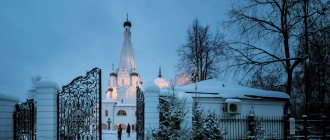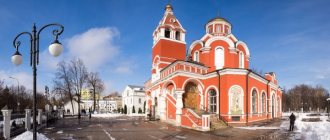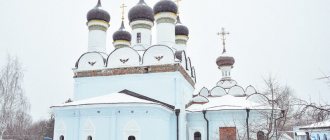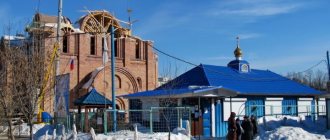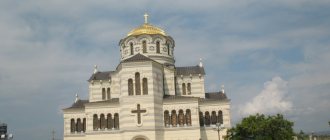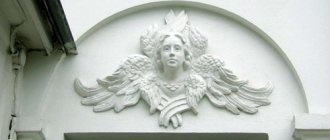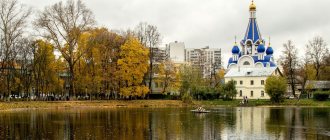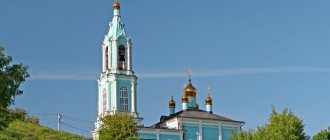Description of the organization
“Church of the Intercession of the Blessed Virgin Mary on the Zyablikovo metro station” is located in Moscow at Yasenevaya, 38a.
The establishment is located in the Orekhovo-Borisovo Yuzhnoe district. You can get here by your own car, search coordinates on the map are 55.6065, 37.7445. It is also possible to get there by metro (the nearest station is “Zyablikovo”), from which the “Church of the Intercession of the Blessed Virgin Mary on the Zyablikovo metro station” is only 600 meters away. This establishment is included in category 1. You can get more information by using the phone or website. Does the Church of the Intercession of the Blessed Virgin Mary on the Zyablikovo metro station have an address and telephone number or are the company's opening hours incorrect? Write to us!
Relevant news
- The Jews deceived the American ambassador
US Ambassador to Israel David Friedman was criticized for a photo with a non-existent Jewish templein Jerusalem. This was reported by The Times of Israel. During a trip to the unofficial Orthodox Jewish capital of Bnei Brak, the diplomat was photographed with a bird's eye view of Jerusalem. However, on the Temple Mount, the Dome of the Rock mosque was painted over...
- World
Policy
23 May 2021, 19:05
In Japan, a Buddhist monk sued the monastery where he serves because of overwork. This was reported by Channel News Asia. A man demands from one of the temples
on Mount Koya-san near the city of Osaka, compensation in the amount of 78 thousand dollars. He was forced to work in a cafe for tourists for two months without days off, his other duties...
- World
Society
18 May 2021, 09:07
The ark with a piece of the robe (clothing) of the Most Holy
Theotokos
was delivered to Krasnoyarsk by plane, writes “Our Krasnoyarsk Territory” on Wednesday, May 16. At the airport, the shrine, which is usually kept in the Trinity-Sergius Lavra, was met by the head of the Krasnoyarsk and Achinsk Metropolis, Panteleimon. The Ark was brought to the chapel of the Great Martyr Paraskeva Friday on Karaulnaya Hill,…
- 69th parallel
Events
16 May 2021, 19:03
Project of the future temple
The architects of the current Church of the Praise of the Blessed Virgin Mary in Zyablikovo, S. Goncharov and D. Rodionov, created a temporary structure for the future shrine.
Temporary Church of the Praise of the Blessed Virgin Mary in Zyablikovo, Moscow
Architect Denis Anatolyevich Rimsha created a unique project for a snow-white, magnificent cathedral, approved on February 14, 2019 by the chairman of the Foundation “Support for the Construction of Moscow Temples.”
Archpriest Andrei Yurevich took part in the design of the Church of Praise of the Most Holy Mother of God in the southern region of Moscow; he headed the working group in temple construction.
According to the project, the future church will be two-tiered with two chapels. The main one is the Praise of the Blessed Virgin Mary, in the second, Peter and Fevronia, a baptistery will be built.
The architecture is based on the Pskov style with borrowed elements from Byzantine churches. The building is given special grandeur by its airy arches and the combination of snow-white covering with blue domes and golden crosses.
The main entrance on the western side of the temple will be decorated with a panel depicting the Feast of the Praise of the Most Pure Mother of God, made of ceramic smalt. The southern portal at the entrance will be decorated with the holy face of the faithful Peter and Fevronia.
Project of the Church of the Praise of the Blessed Virgin Mary in Zyablikovo
Interesting facts and legends
The most interesting facts about the temple in Zyablikovo:
- The Church of the Praise of the Blessed Virgin Mary has its own website on the Internet and maintains a group on VKontakte..
- The Sunday school at the temple has a powerful library and is open to everyone.
- In addition to divine services, the temple ministers also conduct extensive social work.
- Legal registration of the temple was completed in 2013, and the first prayer service was served back in 2012.
- The rector of the church, Archpriest Mikhail Grigorievich Avramenko, was born on November 18, 1967. He received his education at the Moscow Theological Seminary. On September 11, 1993, he received the rank of deacon, and on February 12, 1994, he was ordained to the rank of presbyter.
- Parishioners speak of Father Mikhail as a very strict but fair confessor.
- Priest Alexander Valerievich Emelyanov was born on July 18, 1987, graduated from the Moscow Automobile and Road Institute in 2009 and the Moscow Theological Seminary in 2014. He was ordained as a deacon in 2011, and as a priest in 2014.
- Near the temple there is a swimming pool and a sports ground.
- You can donate money for the construction of the temple not only through bank transfers, but also with the Yandex.money electronic wallet.
Feast of the Praise of the Blessed Virgin Mary
This holiday was founded in the 9th century AD under Emperor Heraclius, when Persian and Scythian warriors were besieging Constantinople. At this time, the people with icons of the Mother of God stood in prayer, seeking protection under the protection of the Queen of Heaven.
Interesting! Emperor Constantine announced that Constantinople was dedicated to the Defender of the city. The Most Pure Virgin repeatedly put enemies to flight, this happened during the attack of the Hagaryan and Persian troops.
During the siege, Christians prayed in the temple of Blachernae all night; in the morning, a huge wave washed away all the enemy ships attacking the city from the sea, and the land enemies fled in disgrace. At this time, according to the decree of the Orthodox Church, the holiday of Praise of the Blessed Virgin Mary was established.
Where to stay
Not far from the temple there are several hotels and hostels where you can stay overnight.
You can get acquainted with them thanks to the table:
| The name of the hotel | Address | Minimum room rate, rub. | Average score, points | Distance from the temple, km |
| Milan | st. Shipilovskaya, 28A | 4900 | 4,8 | 1,1 |
| Hellene | st. Generala Belov, 35 | 500 | 2 | 0,7 |
| Florence | st. Yasenevaya, 41A | 2900 | 4,1 | 1,2 |
| Yasenevo | st. Yasenevaya, 35 | 2900 | 3,7 | 1,2 |
| Clouds | Orekhovy Blvd., 61 building 2A | 1200 | 4 | 1,8 |
There are times when parishioners who have arrived from afar are unable to independently find a place to stay for the night. In this case, the clergy of the temple provides all possible assistance in finding housing. It should also be noted that within walking distance from the temple there are a sufficient number of apartments available for daily or long-term rent.
You can find them on many Internet sites. It is important to remember that when renting housing or checking into a hotel, you must have a passport with you.
The Church of the Praise of the Blessed Virgin Mary, which in the near future will become a real architectural decoration of Zyablikovo, already today receives hundreds of parishioners, and on the holy holiday of the Praise of the Blessed Virgin Mary there will be especially many of them.
Being a deeply religious person, a person who finds himself in Moscow on Saturday in the fifth week of Lent should not miss the opportunity to visit this beautiful and modernly furnished abode of God.
Author: Mikhail Pushkarev
Archnadzor
Rustam Rakhmatullin, Konstantin Mikhailov
First part
Big Stone Bridge
Behind Lenivka, the Kremlin embankment gives way to Prechistenskaya. So, parallel to the Volkhonka River, it was divided into two along Lenivka. The reason for the division was the Stone Bridge at its old location.
The Old Stone Bridge was the first permanent bridge on the Moscow River. The Moskvoretsky Bridge from Red Square for a long time remained floating (“live”) or wooden piled. With the advent of the Stone Bridge, and this is the 1680s, the birthright seemed to return to Borovitskaya Square from Krasnaya. The preference for the Stone Bridge could be dictated by the priority of the Kyiv geopolitical vector in the 17th century, that is, the importance of Zamoskvoretsk Yakimanka as a direct road to Little Russia.
The White City Water Gate Tower was dismantled later than the fortress walls adjacent to it, perhaps because it was seen as part of a bridge. At the Zamoskvoretsk end of the bridge it was answered by the famous Six Gate Tower, dismantled before the Vodyana Tower.
The bridge itself was demolished in 1857. Its iron successor, which existed for eighty years, retained the name Kamenny and transferred it to the current, third bridge.
All Saints Church
Both the Old Bridge and the Water Tower were otherwise called All Saints, after the Church of All Saints, which stood on the Chertol bank a little to the west. The church was the oldest in Chertolye by mention: 1365. That year she gave the name to a fire that started nearby.
The street between the Bolshoi and Maly Kamenny Bridges (now Serafimovicha) was also called Vsekhsvyatskaya. This is also the first name of Lenivka. Both streets have a common red line: across the river it is supported by the famous House on the Embankment, built before the bridge was moved.
The wall of the White City could barely hug the ancient church, which stood at the very edge of the main bank. In place of this section of the wall, a shaft called All Saints has been preserved.
The church existed in the body of the 17th, if not the 16th century and, according to the research of Vladislav Ryabov, belonged to the rarest type of three-domed church. It was abolished and demolished before the construction of the Cathedral of Christ the Savior. The site joined the temple square, becoming its south-eastern corner, and over time was occupied by the monument to Alexander III. The Altar of All Saints moved to the neighboring Church of the Praise of the Virgin Mary.
Church of the Praise of the Virgin Mary in Bashmakovo
In disputes and conversations about the Cathedral of Christ the Savior, almost no one remembers the excellent Moscow temple, which stood next to the grandiose cathedral and shared its fate. Of course, the Church of the Praise of the Virgin Mary could not compete with the Cathedral of Christ either in size or in the luxury of decorative decoration. But in elegance, refinement of lines and proportions, not to mention antiquity, it undoubtedly surpassed him. The church stood to the left of house number 45/1 on Prechistenskaya embankment. The first documentary news about it dates back to 1475.
During the demolition of the temple, an ancient crypt was discovered; The inscription on the stone slab stated that an associate of Ivan the Terrible, the famous Malyuta Skuratov, who was killed in the Livonian War, was buried here. This means that Skuratov’s courtyard in Chertolye was located not far from this church. Where exactly? - mystery.
The temple is shown on the plans of Moscow in the 17th century, starting with Peter’s drawing: a single-domed church looking out from behind the wall of the White City. In 1656, according to the “Building Book” of Moscow, the temple was already made of stone (it is possible that from the time of Skuratov). It was then called differently - the Church of St. Nicholas the Wonderworker of Yavlensky, which is on Prechistenskaya Street. Another toponymic address of the church, indicating antiquity, is also known - “what is in the Old Groves”. The Church of St. Nicholas was also called later, when the miraculous image of St. Nicholas the Appearing moved to the chapel, and the throne of Praise of the Mother of God became the main one. The church was also called Old Proscha - in the meaning of forgiveness, miraculous healing from the icon. By 1917, the Church of Praise remained one of the three Moscow Farewells. (Two others - the churches of St. Nicholas the Revealed, or Novaya Proshcha, on Arbat and Paraskeva Pyatnitsa in Zamoskvorechye - were also demolished during Soviet times.) Finally, the Pokhvalsky Church was also called St. Nicholas in Bashmachki.
Bashmakovo is not the name of an ancient settlement or tract. It comes from the name of a wealthy parishioner, the owner of a neighboring house. Duma nobleman and printer (keeper of the state seal) Dementiy Minich Bashmakov entered his name into the history of architecture when in 1705 he completely rebuilt the Pokhvalskaya Church, which actually stood in his yard. At best, the basements and lower parts of the walls survived from the previous stone building, so the temple, which survived into Soviet times, was a characteristic monument of Moscow architecture at the turn of the 17th - 18th centuries.
The architecture of the Church of the Praise of the Virgin Mary is very curious for the beginning of the 18th century. It belonged to a compromise movement that combined traditional features of Moscow architecture (five domes, a “ship” plan) with newfangled composition techniques (vertical silhouette, refinement of forms, compact completion) and architectural decoration. The “Moscow Baroque” was characterized by scalloped frames, thin columns of faceted drums of the temple and bell tower, an octagonal window in the upper part of the church, and the white stone of all this decoration against the background of brick walls.
Pre-revolutionary researchers pointed out the close connection between the appearance of the Pokhvalskaya Church and the examples of the “German Renaissance” that spread in Moscow in the 1680s: orderly processing of facades, complex ornaments, torn pediments (straight and round), figured brackets, balusters, vases, shells...
The bell tower of the temple did not belong to the hipped type common in the 17th century, but adjoined a smaller group of pillar-shaped octagonal ones.
The interior attracted attention to the carved six-tiered iconostasis from 1705, with icons from the master isographer Kirill Ulanov. In the basement there were, in addition to Skuratov’s, the burials of the temple builder Dementy Bashmakov, his mother and daughter, other parishioners and donors.
The Pokhvalskaya Church did not undergo major reconstruction and, until its destruction, retained the features of the original architecture.
After 1917, the Church of the Praise of the Virgin Mary acquired another shrine - the revered icon of the Mother of God “Unexpected Joy” was transferred here from the demolished Kremlin Church of Constantine and Helena. Since the 1920s, an akathist was read before her every week, on Fridays. The relatively peaceful life of the temple continued until the early 1930s.
The transfer of the site of the Cathedral of Christ the Savior for the construction of the Palace of Soviets automatically decided the fate of the Pokhvalskaya Church. On September 8, 1931, the Moscow Regional Executive Committee decided to demolish it, and a month later it was approved by the All-Russian Central Executive Committee. The temple was soon closed, its parishioners moved to the Church of Blasius in Starokonyushenny Lane. The ruins of the Church of the Savior, blown up on December 5, 1931, were dismantled until the summer of 1932. Then came the final hour of the Church of Our Lady of Praise. By the end of the year she was no longer there.
The “Unexpected Joy” icon moved to the Church of St. Blaise, then to the Church of the Resurrection in Sokolniki, and is now preserved nearby, in the Church of Ilya the Obydenny near Ostozhenka.
Bashmakov Chambers - Pashkov's old house
It is believed that the house with columns, which stood next to the church, in the middle of the courtyard, with the main facade to the embankment, preserved the ancient chambers of Bashmakov at its core. The house and the church were always connected, they appeared together in paintings and photographs. Who knows if Malyuta himself lived here?
In the 18th century, the estate belonged to the Pashkovs. The owner of the house, captain-lieutenant Pyotr Egorovich Pashkov, the son of Tsar Peter's orderly, kept the clergy of the Church of Praise. It was Pyotr Yegorovich who built the most beautiful house in Russia nearby, immortalizing his own name. And Pashkov’s old house quietly disappeared along with the Pokhvalskaya Church, leaving behind a shapeless and ragged courtyard.
Alekseevsky Monastery
The next block along the embankment, before the construction of the Cathedral of Christ the Savior, was occupied by the Alekseevsky Convent. The same one whose abbess allegedly cursed the construction of a new temple.
Alekseevsky Monastery was moved twice. The first time - from its ancient place on Ostozhenka, where it was replaced by the Conception Monastery. The second time - from here, from Chertolye, where it was replaced by the Church of the Savior, to Krasnoe Selo, where it is partially preserved.
Founded by the holy Metropolitan Alexy in the 14th century, the monastery moved to Chertolye at the same time as the Sovereign's stables, in 1547. After the Time of Troubles and fires, it was restored in a tree until Tsarevich Alexei was born to Mikhail Fedorovich Romanov. In 1629-34, the famous royal masters Antipa Konstantinov and Trefil Sharutin erected a stone church of Alexius the Man of God with two tents in the middle of a wooden fence.
Every year on the day of the angel of the Tsarevich, and later Tsar Alexei Mikhailovich, the entire Family went out to the monastery. The service was performed by the patriarch. After the death of the Tsar, the tradition began to fade, but resumed with the birth of Tsarevich Alexei Petrovich. Now the exits to the monastery were headed by Tsar Peter.
The two-tent church remained in the monastery until its abolition.
Seven-peaked tower
The corner tower of the White City, standing above the mouth of Chertory, was called Alekseevskaya. But the name Semiverkhaya is better known for its complex completion device. On ancient plans of the city, the tower is crowned by an indefinite number of tops. According to the observation of the artist and architect Vladislav Ryabov, the tower had eight sides and, therefore, nine tops.
The seven-peaked tower, like the walls, disappeared during the reign of Catherine II. But it remained, together with the tented church of the Alekseevsky Monastery, a favorite subject for architectural reconstructions.
House of Obolonsky
Along the high bank - the remnant of the All Saints Wall - we return to the corner of Lenivka. The corner is nobly rounded by the ancient Obolonsky house (Lenivka, 1/45). The coal rotunda, which has not reached us, is visible in many panoramas. In some angles, the rotunda with a belvedere replaced the Water Gate tower, recreating its urban planning emphasis on the bridgehead intersection and inviting us to Lenivka.
House of Khludovs
The shortest street in Moscow, Lenivka, will quickly return us to Volkhonka.
The house on the corner of the lane (No. 4/6) will not attract attention if you do not know that it is shown in stone already on the plan of 1764. Beneath the plaster there may be traces of Elizabethan baroque decoration, if not something older. Today it is the oldest house in a dilapidated quarter on the site of the ancient Kremlin bridgehead. The most famous in the series of owners of the house is Gerasim Ivanovich Khludov, the largest Moscow industrialist of the mid-19th century, co-owner of the Yegoryevsk paper spinning and weaving factory.
You can enter the estate's courtyard from the side, through the arch of a stylish apartment building at 8 Lebyazhy Lane (1903, architect Alexander Kalmykov). In the center of the courtyard under the Khludovs there was a water pump for the Chinese (Central) baths that belonged to them.
Lobachev's House
The Khludovs' chambers filled the red line of Lenivka, as happens with the oldest houses. In other words, the apartment building on the corner with Volkhonka (No. 6/7) retreated from the ancient red line. Built by civil engineer Nikita Lazarev for the merchant Lobachev in 1904, the house backed away from the growing flow of traffic from the Kamenny Bridge to Znamenka and Mokhovaya.
Church of John the Baptist on Lazy Torzhok and the “house with benches”
The perspective of Lenivka, and therefore the Old Bridge, is closed by the columned portico of house No. 10 on Volkhonka. He took over this urban planning role from the Church of the Conception of John the Baptist, which is on the Lazy Market.
A little more is known about the Baptist Church than about the marketplace itself. It was first mentioned in 1589, shown on all plans of Moscow, starting with Peter’s drawing, and has been listed as stone since 1657. Abolished on the initiative of Prince Alexander Prozorovsky, the last Catherine's governor of Moscow.
The governors were not free in such matters: the sovereigns remained the ruling princes of Moscow. In a submission addressed to the Empress, Prozorovsky wrote about the dilapidation of the temple, and the attached plan dealt with the cramped passage. Having received the highest response, the prince in 1792 proposed to the Deanery Council “to dismantle the Church of John the Baptist on Lenivka next spring, allocate part of the land for widening the street, and give the other part for shops. In the shops opposite the Stone Bridge there would be a portico or portal, very regular in architecture, and would give the bridge an appearance of decoration.” That's what they did.
Moreover, the site being built up was not government property: the former church site successively belonged to the Glebovs, Volkonskys, Shuvalovs, Vyazemskys, Famintsins, and Rinkeviches. Almost all the names are “local”, neighbors.
The Museum of Personal Collections of the Pushkin Museum recently moved to the “House with Benches”.
Estate of the Naryshkins - Voeikovs (Tropinin's house)
From the house with the benches it is convenient to see the estate on the other corner of Lenivka. In the 18th century, it belonged to the Naryshkins and occupied the entire front of a huge block along Lenivka and the entire front along Volkhonka. After the death of Lieutenant General Vasily Naryshkin, the courtyard began to be divided between his nieces, who were getting married. This is how the far part along Lenivka became isolated, with the already familiar coal house near the Old Bridge. The far part along Volkhonka (No. 13) remained with the Naryshkins (now there, in a 19th-century house, there is a museum of Ilya Glazunov). And the closest part (Volkhonka, 9 - 11) was given to his wife by Alexei Fedorovich Griboyedov.
He was Alexander Sergeevich's uncle. Not by his father, as one might think, but by his mother: the playwright’s parents belonged to different branches of the same family. Uncle Khmelita's estate near Vyazma is known as the Griboyedov Museum. The future writer spent the summer of his childhood in Khmelit.
Alexey Fedorovich is considered the prototype of Famusov. His daughter really bore the name Sophia. Then the candidate for Skalozub is her husband Sergei Rimsky-Korsakov, whose house on Strastnoy Boulevard was unfairly known as Famusov’s house.
However, Famusov lived on Volkhonka much earlier than the time of “Woe from Wit.” Back in 1806, he sold the house and moved, to the surprise of the nobles, to Zamoskvorechye. (It’s not for nothing that the heroes of Bunin’s “Clean Monday” are looking for Griboyedov’s house on Ordynka, in Griboyedovsky, now Pyzhevsky Lane.) Alexander Griboyedov had only childhood memories of the house on Volkhonka.
photo: https://www.liveinternet.ru/users/appassionata/post123212373/
Alas, on the site of the main manor house there is now an eclectic building from the second half of the 19th century (Volkhonka, 9, architect Mikhail Nikiforov). The mortgage board, found during the demolition of the old house in 1878, reported that the building being demolished was mortgaged by the widow of Vasily Naryshkin “in the summer of May 1779, 20 days from the Nativity of Christ. The architect of the building was Elezva Semenov, son of Nazarov...” This is a very large architect of the Bazhenov circle.
The existing house was built by Lieutenant Colonel Voeikov. Above the cornice we see two identical coats of arms: on the corner and in the center of the main facade. The second one is better preserved. The coat of arms is topped with a knight's helmet - a sign of an untitled noble family. This is one of three dozen family coats of arms that have survived on Moscow facades. Looking ahead, let’s say: two more are waiting for us on Volkhonka, a prince’s and a count’s. Here you can learn the basics of heraldry.
Voeikov's house is marked with a memorial plaque in honor of the artist Vasily Tropinin. Contrary to its text, Vasily Andreevich could not live within these walls, since he died in 1857. He did not live in the former main house of the estate either. The artist lived in outbuildings - first in a small one on Volkhonka (No. 11), later in a large one on Lenivka (1/9). Both buildings, fortunately, have been preserved.
The details of this story were researched by Sergei Romanyuk. The confessional books of the Church of the Praise of the Virgin Mary in Bashmakovo indicate that at first the artist rented an apartment from the merchant Zimulin, who acquired the estate of Alexei Griboyedov in 1806. But by the time of Tropinin, Zimulin had sold the main house and the outbuilding along Lenivka, and left behind the outbuilding along Volkhonka, built in 1811. (The cartouche with the Latin monogram and the exterior of the outbuilding belong to Voeikov, in whose hands the two parts of the ancient property will be united again.)
According to the lease agreement dated September 1, 1825, Tropinin borrowed from Zimulin “in a stone outbuilding on a large street, the top floor, four rooms and a kitchen, with a gallery with glass.” Downstairs the merchant had shops. The staircase to the artist led from the yard.
Having occupied an apartment on Volkhonka, Tropinin took the place of the first Moscow portrait painter, which had been empty for twenty years, since the death of Rokotov. Karl Bryullov, refusing to portrait Muscovites, told them: “You have your own excellent artist.”
...Rokotov went to Moscow for the retired nobility, who received freedom - the right not to serve. He realized that he would find an order in Moscow. His Muscovite prefers a dress with a lace shirtfront to a St. Petersburg uniform with orders. In Moscow and the Moscow region, free nobles caught up with the Baroque style, began classicism and mixed them. So Rokotov is baroque and classical at the same time.
Tropinin is also placed on the borderland, historical and personal. It closes classicism (Empire style) and opens romanticism. A peasant of Count Morkov, he receives his freedom and the title of academician when the nobility celebrates the beginning of its end in the salons of Decembrism and on Senate Square.
Muscovite Tropinina gradually emerged from the Rokotov fog, rounded his face and body, brightened his eyes and fit into the interior. He also moved from Rokotovskaya Basmannaya to Volkhonka, from Pokrovka to Arbat. “It took me an hour to drive from Pokrovka,” says the old woman at Griboyedov’s, who has not moved.
Moscow itself coins the formula: Tropinin in Famusov’s house.
The Academy invited a new member to come to St. Petersburg, but Vasily Andreevich remained in Moscow. The completeness of the acquired freedom also implied freedom from the Academy. And most importantly, the artist was waiting for the emancipation of his wife and son, who lived with Morkov for another five years. Count Irakli Ivanovich knew how to keep Tropinin nearby! Morkov valued him as a house manager and even as an architect: on the count’s estate of Kukavka near Vinnitsa there is a church designed by Vasily Andreevich.
Vasily Andreevich lived in Zimulin’s wing for seven years. Pushkin, who returned from exile, came here to pose in the winter of 1826-27. Like the owner of the workshop, the poet stood at the turn of time, at the turning point of his life. Let's call Tropinsky's Pushkin Moscow (Kiprensky wrote St. Petersburg's, and these are the best images of the poet).
“Pushkin himself secretly ordered the portrait of Tropinin,” testified the poet’s friend Sergei Sobolevsky, “and presented it to me as a surprise with various farces.” Next is a detective story with the participation of Moscow writers. Leaving abroad for five years, Sobolevsky left the portrait to Ivan Kireyevsky, and he left it to Shevyrev. Sobolevsky returned and found a copy from Shevyrev. It turned out that Kireyevsky gave permission to copy the portrait, and the copyist lived in Shevyrev’s house. In short, who is to blame remains unknown.
Meanwhile, the original was found in a money changer's shop. And surprisingly: the shop was located... in the “House with Shops,” across the street from Tropinin’s apartment. It was as if the portrait itself had returned to its creator. The old artist certified the authenticity of the portrait, but did not restore it, saying that “he does not dare touch the features drawn from life and, moreover, with a young hand.”
By that time, Tropinin had long since moved to another house. This happened in 1832 or 1833. Perhaps because the previous outbuilding changed hands. Or because it became crowded: the artist had already united with his family.
The Tropinins moved into the building on Lenivka, which, together with the main corner house, then belonged to the family of Privy Councilor Pisarev. Vasily Andreevich lived here for more than twenty years. Only a year before his death, in 1856, he purchased his own house on Bolshaya Polyanka (not preserved).
In the mezzanine of the house on Lenivka, one window has been cut out and stands out in size. According to legend, the room outside the window is Tropinin’s workshop. It is believed that it is at this window overlooking the Kremlin that the artist stands in his textbook self-portrait. It is impossible to compare the angles: for the last hundred years the Kremlin has been obscured by Lobachev’s apartment building. Only the window sill is visible in the picture, and it looks like the window is really huge.
The artist more than once seated customers at the window. At first glance at their portraits, the window frame seems to be the frame of paintings hanging on the wall. Here Mr. Protasyev poses in winter at the left corner of the window, overlooking Pashkov’s house and the Church of Nikola Streletsky. Here Mrs. Protasyeva poses in the summer, at the right corner, with a view of the tree bushes and the Trinity Tower of the Kremlin. In the portraits, Pashkov’s house, the church, and the Kremlin are visible above the roofs of nearby buildings.
The Volkhonka landscape turns around Tropinin.
Today the Voeikovs’ house and the outbuilding along Lenivka belong to Moscow. The lower floors are for rent, the upper floors have recently been occupied. The second and third floors of the Tropinin wing are clearly empty. Inexplicably, he was denied protection, meaning he is not a monument.
To be continued
Facebook Print article
Published March 23, 2012 at 11:03 am. Headings: Everyday life of local history. RSS feed of comments for this entry. You can leave a comment, or trackback from your own site.
Social program
Over the 2 years of its existence, the parishioners, with the guidance and support of the rector of the temple, have launched a real social program:
- helping old and poor people;
- support for large families and the sick;
- youth club work;
- the work of circles was organized;
- pilgrimage trips are carried out.
Interior of a temporary temple in Zyablikovo
Patronal holiday
The newly built church in Zyablikovo celebrates its patronal feast day on March 28.
In 2021, Metropolitan Arseny of Istra, first vicar of His Holiness the Patriarch of Moscow and All Rus', archpriest, dean of the Danilovsky district Oleg Vorobyov and rector of the church Archpriest Mikhail Avramenko celebrated the Liturgy in honor of the praise of the Most Holy Theotokos in Zyablikovo in the presence of a large number of people.
Divine service on the patronal feast of the Praise of the Blessed Virgin Mary
The end of the holiday was a joint meal. On June 8, all Orthodox residents of the region and guests are invited to celebrate the anniversary of the church in Zyablikovo.
